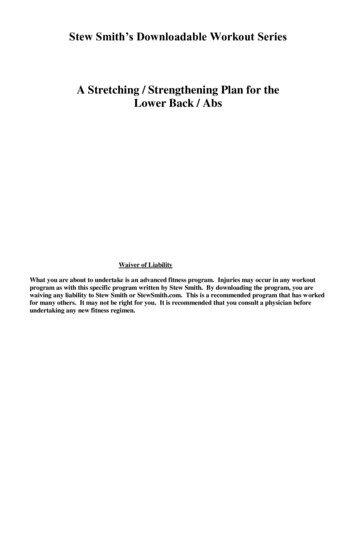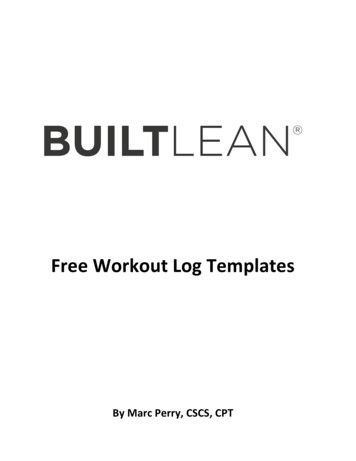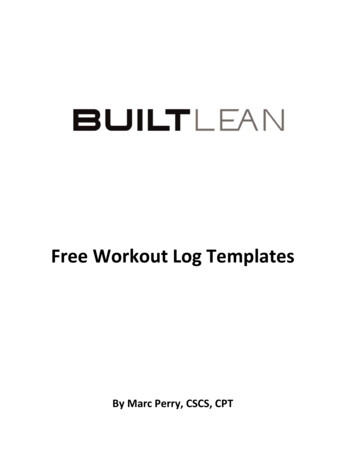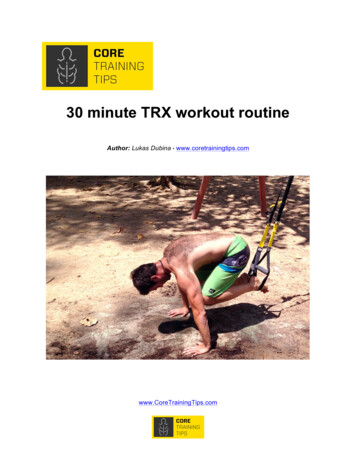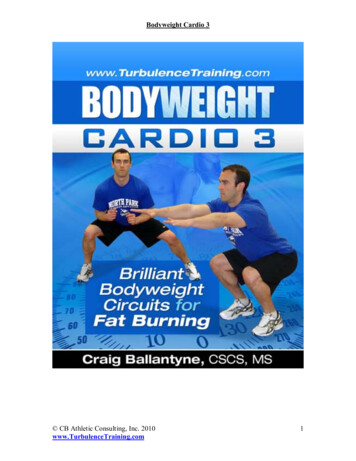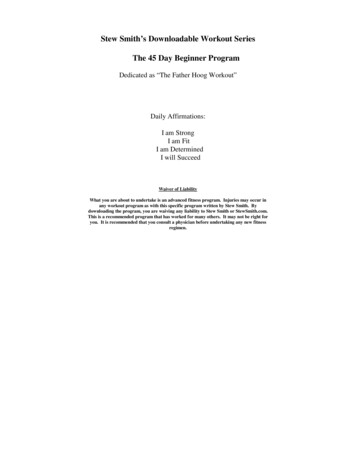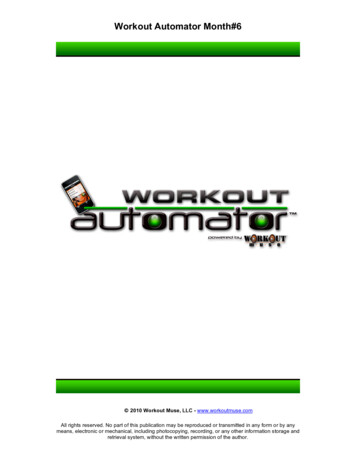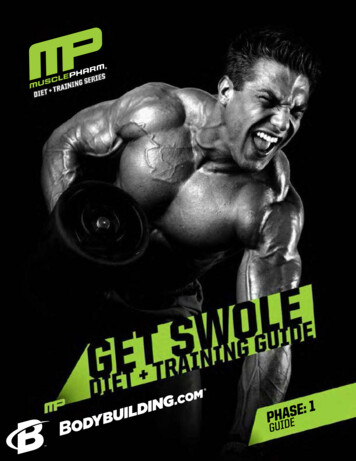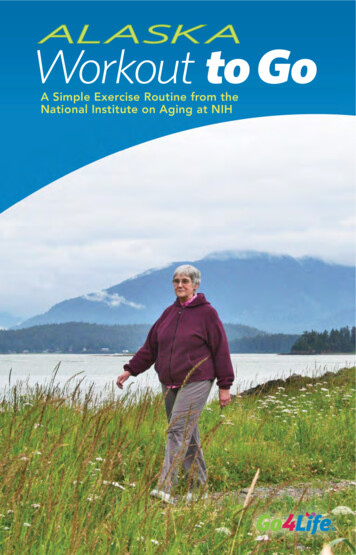
Transcription
AL ASK AWorkout to GoA Simple Exercise Routine from theNational Institute on Aging at NIH
i
Workout to GoAre you just starting to exercise? Getting back into a routineafter a break? Wanting to keep up your physical activitiesaway from home? The 13 exercises in this simple workoutcan help. In this booklet, you’ll find easy-to-follow strength,balance, and flexibility exercises that you cando anytime, anywhere.One of the great things about physical activityis that there are so many ways to be active.This workout is only one of them. The secretto success is to be creative, find activities youenjoy, and keep going.This simple workout is part of Go4Life, an outreachcampaign from the National Institute on Aging at NIH tohelp you fit exercise and physical activity into your daily life.For more exercises, motivational tips, real-life success stories,and other free materials, visit our website:www.nia.nih.gov/Go4LifeGo4Life is a registered trademark of the U.S. Department ofHealth and Human Services.ii
1Get ReadyBefore you begin, here are a few things to keep in mind. Safety always comes first.If you haven’t had regular checkups, you might want totalk with your doctor about your workout plans. Ask ifthere are any reasons to modify your program or adjustthe exercises to do them safely. Always listen to yourbody and do what you can as long as you’re comfortable.Drink plenty of water.Unless your doctor has asked you to limit fluids, be sureto drink water when you exercise. Many older adultsdon’t feel thirsty even when their body needs fluids.Wear comfortable clothes.Be sure to wear clothes that let you move freely.
Get SetFor the workout, you’ll need two tennis balls, a sturdy chairwith arms, a towel, and two equally weighted objects—likehand or wrist weights, soup cans, or water bottles. You mayneed to use 1- or 2-pound weights when starting out. As theexercises become easier, gradually add more weight.You will start the simple workout by warming up. Then,move on to the strength and balance exercises. For eachexercise, we show one set of 10-15 repetitions. Try doing3 sets, and then cool down with the flexibility exercises.What You NeedWHAT YOU NEED2
3Safety Tips Breathe regularly during strength exercises.For example, breathe out as you lift the weight, andbreathe in as you relax. When doing leg lifts, breathe outas you lift your leg and breathe in as you lower it.Use smooth, steady movements when lifting weights.To prevent injury, don’t jerk or thrust weights into position.Keep your arm and leg joints slightly bent.Avoid “locking” your arm and leg joints in a tightlystraightened position.Choose a sturdy chair with arms.Make sure the chair is stable enough to support youwhen seated or when holding on during the exercise.Make slow, steady movements.Never “bounce” into a stretch.Always bend forward from the hips, not the waist.If you keep your back straight, you’re bending the right way.Stop if you feel pain.You might feel some soreness after you exercise, butexercise should not hurt or make you feel really tired. Infact, in many ways, being active will probably make youfeel better.
WARM UPIt’s important to spend about 5 minutes at thebeginning of your routine to warm up. Warmingup gives your muscles a chance to get ready towork. Warm-up activities can help you preventinjury and reduce muscle soreness later.Suggestions Take a walk.Ride a bike.Dance around your living room or kitchen.Walk up and down the stairs a few times.4
STRENGTHSTRENGTH EXERCISESHand Grip1Hold a tennis ball in each hand.2Slowly squeeze the ball as hard as you can and hold itfor 3-5 seconds.3Relax the squeeze slowly.4Repeat 10-15 times.5
Wall Push-Up1Face a wall, standing a little farther than arm’s lengthaway, feet shoulder-width apart.2Lean forward and put your palms flat against the wallat shoulder height and shoulder-width apart.3Slowly bend your elbows and lower your upper bodytoward the wall. Keep your feet flat on the floor.4Hold the position for 1 second.5Slowly push yourself back until your arms are straight.6Repeat 10-15 times.STRENGTH6
STRENGTHOverhead Arm RaiseYou can do this exercise while standing or sitting withyour feet flat on the floor, shoulder-width apart.1Hold weights at your sides at shoulder height withpalms facing forward.2Slowly raise both arms up over your head keepingyour elbows slightly bent.3Hold the position for 1 second.4Slowly lower your arms.5Repeat 10-15 times. TIP: As you progress, use a heavier weightand alternate arms until you can lift the weightcomfortably with both arms.7
Back Leg Raise1Stand behind a sturdy chair, holding on for balance.2Slowly lift one leg straight back without bending yourknee or pointing your toes. Try not to lean forward.The leg you’re standing on should be slightly bent.3Hold the position for 1 second.4Slowly lower your leg.5Repeat 10-15 times.6Repeat 10-15 times with the other leg. TIP: As you progress, you may want to addankle weights. You also can challenge yourself toimprove your balance (see page 14).STRENGTH8
STRENGTHSide Leg Raise1Stand behind a sturdy chair, holding on for balance.2Slowly lift one leg out to the side. Keep your backstraight and your toes facing forward. The leg you’restanding on should be slightly bent.3Hold the position for 1 second.4Slowly lower your leg.5Repeat 10-15 times.6Repeat 10-15 times with the other leg. TIP: As you progress, you may want to add ankleweights. You also can challenge yourself to improveyour balance (see page 14).9
Toe Stand1Stand behind a sturdy chair, feet shoulder-width apart,holding on for balance.2Slowly stand on tiptoes as high as possible.3Hold the position for 1 second.4Slowly lower heels to the floor.5Repeat 10-15 times. TIP: As you progress, try doing the exercise standingon one leg at a time for a total of 10-15 times on eachleg. You also can challenge yourself to improve yourbalance (see page 14).STRENGTH10
11BALANCE EXERCISESStand on One Foot1Stand on one foot behind a sturdy chair, holding onfor balance.2Hold the position for 10 seconds.3Repeat 10-15 times.4Repeat 10-15 times with the other leg. TIP: As you progress, you can also challengeyourself to improve your balance (see page 14).
Heel-to-Toe WalkIf you are unsteady on your feet, try doing this exercisenear a wall so you can steady yourself if you need to.1Place the heel of one foot just in front of the toes ofthe other foot so that they touch or almost touch.Raise arms to your sides, shoulder height.2Choose a spot ahead of you and focus on it to keepyou steady as you walk.3Take a step. Put your heel just in front of your other foot.4Repeat for 20 steps.BALANCE12
BALANCEBalance Walk1Raise arms to your sides, shoulder height.2Choose a spot ahead of you and focus on it to keepyou steady as you walk.3Walk in a straight line with one foot in front of the other.4As you walk, lift your back leg. Pause for 1 secondbefore stepping forward.5Repeat for 20 steps. TIP: As you progress, try looking from side to sideas you walk, but skip this step if you have innerear problems.13
CHALLENGE YOURSELF TOIMPROVE YOUR BALANCEExercises to strengthen your legs and ankles alsocan help improve your balance. As you progress,try adding these challenges to help even more. Start by holding on to a study chair with bothhands for support.To challenge yourself further, try holding onwith only one hand.As you feel steady, use just one finger for balance,or try the exercises without holding on.When you are steady on your feet, try doing theexercises with your eyes closed.BALANCE14
FLEXIBILITYCOOL DOWNCooling down at the end of your workout givesyour muscles a chance to gradually return to rest.Again, this is important to prevent injury. To cooldown, take about 5 minutes to do the following4 flexibility exercises.FLEXIBILITY EXERCISESAnkles1Sit securely toward the edge of a sturdy chair.2Stretch your legs out in front of you.3With your heels on the floor, bend your ankles to pointtoes toward you.4Hold the position for 10-30 seconds.5Bend ankles to point toes away from you and hold for10-30 seconds.6Repeat 3-5 times.15
BackIf you’ve had hip or back surgery, talk with your doctorbefore trying this stretch.1Sit toward the front of a sturdy chair with armrests,with your feet flat on the floor, shoulder-width apart.Stay as straight as possible.2Slowly twist to the left from your waist without moving your hips. Turn your head to the left. Lift your lefthand and hold on to the left arm of the chair. Placeyour right hand on the outside of your left thigh.3Hold the position for 10-30 seconds. Slowly return toface forward.4Repeat 3-5 times. Reverse positions and repeat 3-5times on the right side. TIP: As you progress, try lifting your left arm andresting it comfortably on the back of the chair. Holdon to the left armrest with your right arm. Repeat onyour right side.FLEXIBILITY16
FLEXIBILITYThighIf you’ve had hip or back surgery, talk with your doctorbefore doing this stretch.1Stand behind a sturdy chair with your feet shoulderwidth apart and knees straight, but not locked.2Hold on to the chair for balance with your right hand.3Bend your left leg back and grab your foot in your lefthand. Keep your knee pointed to the floor. If you can’tgrab your ankle, loop a resistance band, belt, or towelaround your foot and hold both ends.4Gently pull your leg until you feel a stretch in your thigh.5Hold the position for 10-30 seconds.6Repeat 3-5 times.7Repeat 3-5 times with your right leg.17
Shoulder and Upper ArmIf you have shoulder problems, talk with your doctorbefore trying this stretch.1Stand with your feet shoulder-width apart.2Hold one end of a towel in your right hand.3Raise and bend your right arm to drape the toweldown your back.4Reach behind your lower back and grasp the towelwith your left hand.5Pull the towel down with your left hand. Stop whenyou feel a stretch in your right shoulder.6Repeat 3-5 times.7Reverse positions and repeat 3-5 times to stretch yourleft shoulder. TIP: As you progress, try pulling the towel downfarther, but not so far that it hurts.FLEXIBILITY18
FLEXIBILITYPROGRESSINGYou should begin to feel stronger and moreenergetic once you start exercising regularly. Theexercises will get easier. This tells you that yourbody is getting used to a higher level of activity, andit’s time to build on those benefits by doing more.Gradually increase the amount of weight you use tobuild strength, try some of the challenges on page 14to improve your balance, or reach farther in yourstretching exercises.Don’t forget to congratulate yourself on yourefforts. You’ve made great progress and you’reready to do more!19
Find Out MoreFor more information on how to exercise safely, check outthe following FREE resources from Go4Life, the exerciseand physical activity campaign from the National Instituteon Aging at NIH. Visit the Go4Life website at www.nia.nih.gov/Go4LifeBe part of the Go4Life Team. UseMy Go4Life to make your ownexercise plan and track your progress, share your success story, andcheck out other free resources.Exercise & Physical Activity: Your Everyday Guidefrom the National Institute on AgingThis easy-to-read print book,available in English and Spanish,has additional sample exercises,worksheets to help you track yourprogress, tips on healthy eating,real-life success stories, and moreideas to encourage you to exercisesafely and build up the benefits.Go4Life Everyday Exercises from the NationalInstitute on Aging (DVD)Join personal trainer Sandy Magrathand friends as they show you howto do strength, balance, and flexibility exercises. This DVD featuresexercises you can do at home, atwork, in the gym, almost anywhere.Mix and match them. Be creativeand have fun!20
Designed to fit easily into your purse or travel bag,Workout to Go can help you stay in shape for theactivities you enjoy most—biking, dancing, workingin the garden, or playing with your grandchildren.You can do these easy-to-follow strength, balance,and flexibility exercise anytime, anywhere!“I love living life to its fullest, but with my familyresponsibilities and my volunteer work, life can getpretty hectic. This wonderful Go4Life resource helpsme stay fit and exercise safely. And what’s great isI can do these exercises wherever I happen to be.”—Pat Lynch, age 60“As a doctor, I’m an ardent believer in exercise andeating well. Several years ago, I started doing dailystrength and balance exercises as recommendedin the exercise guide from the National Instituteon Aging at NIH. These simple exercises help memaintain my active lifestyle.”—Samarendra Dutta, MD, PhD, age 87Preveiontectromotion Pon ProntiNational Institute on AgingNational Institutes of HealthPublication No. 11-4258October 2011The Workout to Go publication was adapted from the National Institute on Aging at NIH inMarch 2012 by the Alaska Department of Health and Social Services, Division of Public Health,Section of Chronic Disease Prevention and Health Promotion, Injury Prevention Program.Adapted and printed with permission from NIA.This publication was printed at a cost of .0.72 per copy in Anchorage, Alaska. This cost block isrequired by AS 44.99.210.C4
For the workout, you'll need two tennis balls, a sturdy chair . with arms, a towel, and two equally weighted objects—like hand or wrist weights, soup cans, or water bottles. You may need to use 1- or 2-pound weights when starting out. As the exercises become easier, gradually add more weight. You will start the simple workout by warming up .

